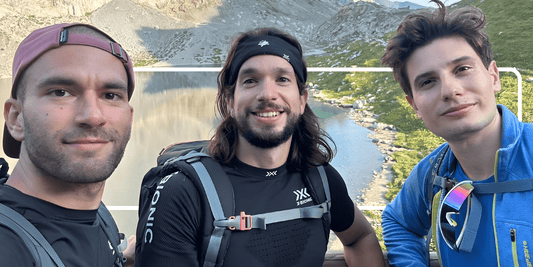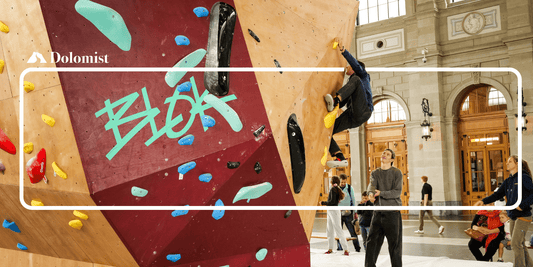Table of Contents
- Why snowshoeing?
- Planning your outing: weather and route
- Layered clothing for winter snowshoeing
- Boots and snowshoes: how to choose
- Mountain Safety: First Aid Kits and Best Practices
- What to bring in your backpack
- Conclusions
1. Why snowshoeing?
Silence, snow and connection with nature : winter snowshoeing is an authentic way to experience the mountains at the rhythm of your own steps. By venturing onto snowy trails, you rediscover a deep connection with the environment, walking lightly on a fragile and precious ecosystem.
- Activity suitable for everyone : from beginners to families, up to the most experienced hikers.
- Physical and mental benefits : the leg and core muscles work intensely, while the snowy scenery gives a deep sense of peace and regeneration.
“We must protect nature if we want to continue to enjoy it. Walking with respect is the first step.”
2. Plan your outing: weather and route
Before putting on snowshoes, safety and awareness begin with preparation:
2.1 Check the weather and avalanche bulletin
- Official websites and dedicated apps inform you about conditions at high altitude.
- If the risk is high, it is better to opt for an alternative itinerary or postpone the exit.
2.2 Study the route
- Select a trail based on your fitness level and experience.
- Use paper maps, apps like Komoot or ViewRanger, and hiking forums for up-to-date information.
2.3 Communicate your plans
- Let your family or friends know which route you have chosen and when you plan to return.
- In case of unforeseen events, it will be easier to locate you.
Remember: the mountain welcomes us, but must always be respected.
3. Layered clothing for winter snowshoeing
3.1 Base layer
- Choose breathable fabrics (merino wool, recycled technical fibers) to stay dry and maintain body temperature.
- Avoid cotton: it absorbs sweat and cools you down quickly.
3.2 Intermediate layer (insulation)
- A lightweight fleece or fleece retains heat while allowing freedom of movement.
- For cold temperatures, add a synthetic fiber jacket , possibly with recycled or certified materials.
3.3 Outer layer (waterproof and windproof shell)
- Opt for a waterproof, windproof and breathable jacket (Gore-Tex® or equivalent).
- Some brands develop high-performance technologies with an eye on the environment, reducing waste and using sustainable production processes.
3.4 Essential accessories
- Thermal gloves, hat and neck warmer : protect sensitive areas where the greatest heat loss occurs.
- Gaiters : If you're walking in fresh snow, they prevent snow from getting into your boots.
4. Boots and snowshoes: how to choose
4.1 Winter boots
- Waterproof : to face snow and humidity without getting your feet wet.
- Thermal insulation : keeps the internal temperature constant.
- Non-slip sole : deep lugs and reliable grip on icy surfaces.
4.2 Snowshoes
- Basic models : recommended for beginners, ideal for beaten paths.
- Technical models : equipped with more aggressive crampons and advanced closure systems, suitable for significant differences in height.
- Check the maximum load capacity and the attachment mechanism : stability is essential, especially on fresh snow or ice.
5. Mountain safety: first aid kits and best practices
-
First aid kit
- Band-aids, disinfectant, gauze and elastic bands. Always keep a spare painkiller.
-
ARTVA, shovel and probe (off-piste)
- If you explore avalanche risk areas, equip yourself with these tools and acquire the necessary skills (specific courses).
-
Respect the ecosystem
- Don't disturb wildlife: during winter, animals already face critical conditions.
- Pick up any trash along the way, leaving the trail better than you found it.
6. What to bring in your backpack
Essential equipment helps you deal with unexpected events without weighing you down unnecessarily:
| Object | Why is it important? |
|---|---|
| Thermos with hot drink | Maintains body heat and hydrates effectively |
| Extra layer (light fleece) | Essential during stops or if the weather changes suddenly |
| Head torch | In winter it gets dark early, useful in case of late returns |
| Trekking poles | Increase stability, better if with snow washers |
| Power bank | To charge smartphones and emergency devices |
7. Conclusions
Winter snowshoeing is a call to slowness, an invitation to immerse yourself in the mountains at your own pace, listening to the crackling of the snow under your steps and admiring the muffled landscape.
Need help choosing the perfect gear for your winter adventures?
Visit our Shop to find high-quality technical clothing and winter accessories, selected with an eye to the environment and sustainability.
Tell us about your snowshoeing experience! Share your photos or anecdotes on our social media channels or in the comments. Each story is a step closer to discovering (and protecting) this fascinating season.
Enjoy your snowshoeing and walk lightly!




